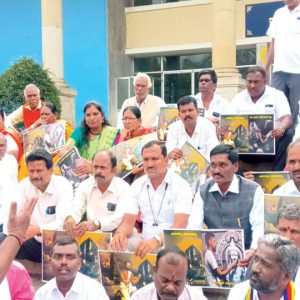How about diversified market system?
By D. Shrijaya Devaraja Urs, Professor & former Director, Institute of Development Studies, UoM
Much has been written and debated about India’s farm laws, often through polarised perspectives. However, meaningful reform requires a nuanced understanding of agricultural markets, farmer livelihoods and policy impacts.
Drawing from my four decades of teaching, research and first-hand engagement with farmers, policy-makers and scholars, I reflect on the realities of India’s agricultural landscape.
To structure my thoughts, I have divided this piece into two sections:
1. Personal Experiences, where I share insights through anecdotes from my journey.
2. Possible Solutions & Recommendations, where I present my views on the road ahead.
My Personal Experiences and Efforts
This discussion stems from a video posted by an unidentified brinjal grower who, despite demonstrating expertise in vegetable cultivation (evident from the heaps of harvested brinjal), advocates for the reintroduction of BJP’s farm laws as a universal solution for farmers’ problems. This claim, however, is both simplistic and misleading.
A key principle in agriculture is that perishable crops, like vegetables, cannot be cultivated on a large scale without robust infrastructure — efficient harvesting methods, cold storage, packaging, transportation networks and processing centres. Drawing from my own experiences, I cite Israel as an example. Their agricultural model, backed by strong government policies, ensures large-scale exports and domestic supply.
For small farmers, the only viable alternative is direct-to-consumer sales. I recall my 1979 field visit to Tel Aviv airport, where I witnessed two jumbo jets loaded with fresh produce taking off in the early morning for global markets. This was made possible by advanced information systems that dynamically redirected flights based on real-time market conditions across Europe and beyond.
Implementing an APMC-like model for perishables such as brinjal requires sophisticated infrastructure. Essential elements include price discovery mechanisms, large-scale storage, efficient transportation and logistical support to minimise waste and ensure smooth market operations.
There are no simple solutions to the complex challenges facing Indian farmers. In 2012, I invited Prof. Panini as a Visiting Professor for the Devaraj Urs Chair at Institute of Development Studies (IDS), Manasagangothri campus, later invited him to Head the Devaraj Urs Centre for Development Studies at MYRA School of Business in Yelwal. Our goal was to foster serious academic discourse on agricultural issues — conversations that corporate groups and even business school faculty largely ignored.
In 2017, under the Devaraj Urs Centre at MYRA, we organised an exclusive session on agricultural marketing, bringing together leading experts, administrators and farmer groups. This effort was driven by my research student, Prof. T.N. Prakash (then Chairman of the Farmers’ Commission), who sought my guidance in drafting policy proposals for Karnataka’s agricultural marketing reforms.
Another of my students, Dr. Manoj Rajan, successfully developed and implemented the ReMS model — an initiative Karnataka pioneered. Unfortunately, the Central government later adopted it as a national model without fully understanding its limitations.
This exemplifies my core criticism of BJP’s approach — imposing a “one nation, one model” policy, disregarding the intricate diversity of Indian agriculture. With over 300 agricultural commodities, each with distinct challenges, a uniform policy is neither practical nor effective.
The renowned Nobel Laureate Prof. Theodore Schultz, a scholar of Indian agriculture, concluded that small Indian farmers are as efficient as their global counterparts. When I began teaching at IDS, Prof. Misra assigned Schultz’s Transforming Traditional Agriculture as a foundational text, shaping my understanding of agricultural transformation.
My experiences as a farmer until 1996, along with interactions with scholars such as Prof. Uma Lele (World Bank), Prof. John Mellor (DG, IFPRI) and experts from FAO/UNDP, further solidified my perspectives.
Additionally, my research on Karnataka’s 116 agricultural markets (1975-77) for a World Bank project deepened my insights into market complexities.
Despite my efforts, institutional inertia often obstructs meaningful reform. In 1985 and 1987, with support from a Ford Foundation grant, I facilitated study visits for senior administrators H.K. Shivananda and H.L. Gangadharappa to the US, where they engaged with USDA divisions and studied advanced market models, including Amish farmers’ markets near Philadelphia. Regarding farmers’ markets in the US, the USDA’s Farmers Market Development Programme, launched in the 1980s, has grown to nearly 8,000 markets nationwide.
I urged them to develop at least one similar rural market and cattle markets (out of 1,132) as a demonstration model in Karnataka, but bureaucratic resistance stalled progress. Despite Karnataka State Agricultural Marketing Board’s (KSAMB) resources, it diverted land from the Gangothri campus under the pretence of collaboration, ultimately abandoning funding for India’s first world-class Agricultural Marketing Management Programme at IDS.
In 1986, we organised a National Conference at IDS to commemorate the centenary of market regulation in India — a milestone even the Ministry of Agriculture overlooked. We emphasised informal markets under the theme “Rural Markets: Alternatives for the 21st Century,” but these insights went largely unheeded.
Possible Solutions
The farm laws debate in India underscores the tension between neo-liberal reforms and protective welfare measures. While the laws aimed to transform agriculture, their abrupt introduction — without adequate stakeholder consultation or safeguards — generated distrust. Future reforms must prioritise inclusive dialogue, phased implementation and robust safety nets to balance productivity with equity in India’s agricultural sector.
The discussion has highlighted critical issues such as market access, price assurance, supply chains and farmer welfare. While the repealed laws aimed to liberalise agriculture, they also raised concerns about the role of Corporations, MSP (Minimum Support Price) and APMC (Agricultural Produce Market Committee) markets.
1. Modernise APMC Mandis while enabling alternative markets:
• Rather than dismantling APMCs, they should be modernised with better infrastructure, digital price discovery mechanisms and transparent auctions.
• Private markets can coexist with APMCs to ensure competition rather than replacement.
2. Legal guarantee of MSP with a hybrid procurement model:
• Farmers demand MSP as a legal right. A possible solution is a hybrid procurement model — Government continues direct procurement for key crops (for example, wheat, rice).
• Price deficiency payments: If a farmer sells below MSP, the government pays the difference.
• Market-driven MSP realisation through a regulated private sector with oversight.
Several countries offer useful policy models:
• European Union: The Common Agricultural Policy (CAP) ensures direct payments and market interventions for price stability.
• Brazil: The government guarantees minimum prices and provides low-interest loans to shield farmers from market fluctuations.
3. Regulation of Contract Farming and Fair Pricing Mechanisms:
• Contract farming can benefit farmers but requires strict regulations to prevent exploitation.
• Model contracts should include price assurance, quality parameters and dispute resolution.
Relevant international policies include:
• United States — Agricultural Fair Practices Act (1967) protects farmers from unfair trade practices.
• European Union — Unfair Trading Practices Directive (2019) mandates written contracts and bans exploitative clauses.
• Brazil, Thailand, Philippines and South Africa have enacted similar laws to regulate fair contract farming practices.
4. Enhancing Farmer Producer Organisations (FPOs):
• Strengthening FPOs can help farmers aggregate produce, secure better prices and negotiate fair contracts.
• FPOs need financial and logistical support to enable collective bargaining.
5. Decentralised Warehousing and Cold Storage:
• Expanding village-level storage and cold storage chains will reduce distress sales.
• The Gramin Agricultural Markets (GrAMs) initiative can be leveraged for decentralised procurement.
6. Digital and Financial Inclusion for Farmers:
• E-NAM (National Agricultural Market) should be expanded with user-friendly digital platforms.
• Direct Benefit Transfers (DBT) can replace inefficient subsidies for targeted assistance.
7. Crop Diversification and Sustainable Agriculture:
• Incentivising diversification beyond wheat and rice can reduce overproduction and conserve resources.
• Promoting millets, pulses and oilseeds can reduce dependency on imports.
8. Participatory Policy-making with Farmers:
• Any new farm law reform must involve consultations with farmers’ unions, economists and agricultural scientists.
• Pilot testing in select States before full implementation will help assess impact.
With 86% of Indian farmers being smallholders, reforms must be nuanced and context specific. Global case studies reinforce the need for tailored policies rather than blanket solutions.
The ideal marketing solution lies in strengthening a diversified market system, including commodity boards, co-operatives, contract markets with regulatory oversight, Regulated Market Committees (RMCs), farmers’ markets and other para-statal institutions.








Recent Comments